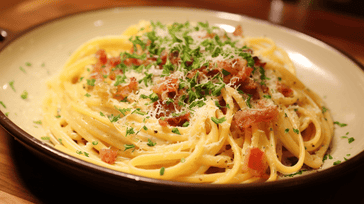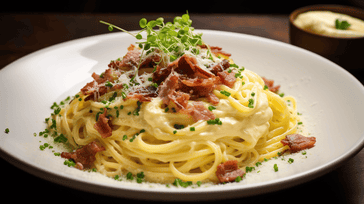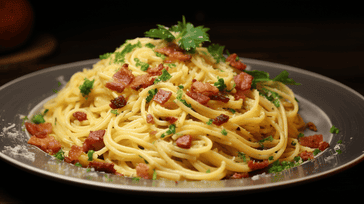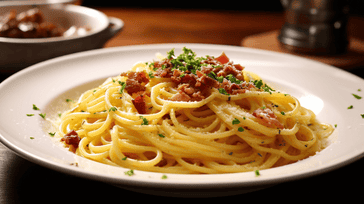
Welcome to our ultimate guide to perfecting spaghetti carbonara! If you're a fan of this classic Italian dish, you've come to the right place. We've compiled everything you need to know to create an authentic and delicious carbonara, from understanding its history and key ingredients to providing a step-by-step recipe and troubleshooting tips. Whether you're a seasoned chef or a beginner, our guide has something for everyone. So, get your apron on and let's get cooking!
Spaghetti carbonara is a classic Italian pasta dish with a rich history and a distinctive flavor profile. This beloved comfort food is known for its creamy sauce, made with eggs, cheese, and pancetta, which is tossed with al dente spaghetti and finished with a sprinkle of black pepper. While there are variations of carbonara that include cream, garlic, or peas, a traditional carbonara has only a handful of ingredients, requiring careful technique to produce a velvety, smooth sauce.
The origins of spaghetti carbonara are somewhat shrouded in mystery, with different theories proposed over the years. Some people believe that carbonara was invented by Italian charcoal workers, who used eggs, cheese, and pancetta to create a filling meal during long work shifts. Others suggest that carbonara was a dish created by Italian peasants during World War II, using American bacon and powdered eggs donated by the US Army.
Regardless of its precise origins, spaghetti carbonara has become an iconic dish that is beloved around the world. While it can be a complex dish to master, with the right ingredients and a little patience, anyone can produce a delicious and authentic carbonara. In the following sections, we'll explore the key elements of a traditional carbonara sauce, offer step-by-step instructions for making your own at home, and provide tips and suggestions for perfecting your technique.

When it comes to creating an authentic carbonara dish, the sauce is one of the most crucial elements. To achieve that classic creaminess, there are four key ingredients that should not be overlooked.
| Ingredient | Description |
|---|---|
| Eggs | Whisked together with cheese and black pepper, eggs form the basis of the carbonara sauce. They provide a rich, velvety texture that perfectly coats the pasta. |
| Cheese | Pecorino Romano is the traditional cheese used in carbonara, providing a sharp, salty flavor that balances out the richness of the eggs and pancetta. Some recipes also incorporate Parmesan cheese. |
| Pancetta | While bacon is a popular substitute, pancetta is the most authentic option for carbonara. It's a type of Italian cured pork belly that adds a salty, smoky flavor to the dish. |
| Black Pepper | Black pepper is a key ingredient in carbonara, providing a spicy kick that complements the other flavors. Freshly ground pepper is recommended for the best taste. |
It's important to note that cream is not a traditional ingredient in carbonara. While some recipes do call for it, a true Italian carbonara should be made without cream, allowing the eggs and cheese to provide the desired creaminess.
For an even richer sauce, some cooks add an extra egg yolk to the sauce mixture. This will create an even creamier texture.
If you're ready to embark on the journey of making your own authentic spaghetti carbonara, follow these simple steps for a delicious and easy-to-make meal.
| Ingredient | Amount |
|---|---|
| Spaghetti | 1 pound |
| Pancetta (or bacon) | 4 ounces |
| Eggs | 4 |
| Pecorino Romano cheese, grated | 1 cup |
| Black pepper | To taste |
That's it - with just a few simple steps, you can create a mouth-watering spaghetti carbonara that's sure to impress. Remember to use quality ingredients and follow the recipe closely for the most authentic and delicious results.

If you're looking to put your own spin on the traditional carbonara recipe, there are countless variations and creative twists you can try. From adding different types of cheese to experimenting with alternative ingredients, the possibilities are endless.
If you're a vegetarian or simply want to add some greens to your carbonara, try adding sautéed mushrooms, spinach, or asparagus to the dish. Not only do these vegetables add some nutritional value, but they also complement the rich and savory flavors of the carbonara sauce.
For a luxurious twist on the classic carbonara, try adding seafood such as shrimp or scallops to the dish. The sweetness of the seafood pairs well with the salty pancetta and creamy sauce, creating a decadent and indulgent meal.
If you like some heat in your food, add some red pepper flakes or chili powder to your carbonara sauce. This will give the dish a fiery kick, balancing out the richness of the sauce and adding an extra layer of flavor.
While parmesan cheese is the traditional choice for carbonara, you can experiment with other types of hard, salty cheeses. Try pecorino romano, asiago, or even aged cheddar for a unique twist on the classic dish.
With these creative variations, you can enjoy the bold and delicious flavors of carbonara while putting your own unique twist on this traditional Italian dish.
Creating an authentic and delicious spaghetti carbonara requires attention to detail and proper technique. Here are some tips to help you perfect your carbonara game:
Make sure to cook your spaghetti until it is al dente, which means it has a firm texture, but is not too hard. This will prevent it from becoming mushy when combined with the sauce.
To ensure a smooth and creamy texture for your carbonara sauce, it's important to whisk the eggs thoroughly before adding them to the pan. This will help prevent clumps and create a velvety consistency.
Authentic carbonara calls for Pecorino Romano cheese, but you can also use Parmigiano-Reggiano or a combination of both. Make sure to use high-quality cheese for the best flavor and texture.
When cooking the pancetta, it's important to render it slowly over low heat to release the flavorful fat. This will also prevent the pancetta from becoming too crispy and adding a burnt taste to the dish.
Once the spaghetti and carbonara sauce are ready, remove the pan from heat before combining the two. This will prevent the eggs from overcooking and scrambling, resulting in a lumpy and unappetizing dish.
Black pepper is a key component of carbonara, adding a spicy kick to the creamy sauce. Add it to taste, adjusting the amount depending on your preference for heat.
With these tips under your belt, you're well on your way to creating a perfect spaghetti carbonara every time!

Spaghetti carbonara is a delicious and filling dish on its own, but serving it alongside complementary sides can take it to the next level. Here are some suggestions for dishes that pair well with carbonara:
| Side Dish | Description |
|---|---|
| Simple Salad | A light mixed greens salad with a tangy vinaigrette can provide a refreshing contrast to the richness of the carbonara. |
| Garlic Bread | Warm, buttery garlic bread is the perfect accompaniment to soak up any leftover sauce and enhance the flavors of the dish. |
| Sautéed Vegetables | Broccoli, asparagus, or mushrooms sautéed with garlic and olive oil can provide a healthy and flavorful addition to the meal. |
Experiment with different sides and find the combination that works best for you. Whatever sides you choose, make sure to keep the focus on the star of the show: the delicious and authentic spaghetti carbonara.
Pairing wine with food is an art form, and spaghetti carbonara is no exception. The right wine can enhance the flavors of the dish, creating a harmonious balance of taste. Here are some suggestions for wine pairing with spaghetti carbonara:
| Type of Wine | Recommendation |
|---|---|
| White Wine | A dry white wine, such as Pinot Grigio or Soave, pairs well with spaghetti carbonara. The acidity of the wine complements the richness of the dish, cutting through the creaminess and bringing out the flavors of the pancetta and cheese. |
| Red Wine | A light-bodied red wine, such as Barbera or Chianti, can also be a good match for carbonara. The fruity flavors and mild tannins complement the saltiness of the pancetta and the creaminess of the sauce. |
Ultimately, the choice of wine to pair with spaghetti carbonara is a matter of personal preference. It's always a good idea to experiment with different wines and find the one that best suits your taste and enhances the flavors of this classic Italian dish.
Leftover carbonara can make for an easy and delicious meal the next day. However, reheating carbonara can be a bit tricky, as the sauce can become dry or overcooked if not handled properly. Here are some tips on how to reheat and enjoy your leftover carbonara:
With these tips, you can enjoy your leftover carbonara as a quick and easy meal without sacrificing any of the delicious flavors.
Making spaghetti carbonara can be a daunting task, but don't worry, we have you covered! Here are some common issues you might encounter when preparing this classic Italian dish and solutions to overcome them:
| Issue | Solution |
|---|---|
| The sauce is too thick and clumpy. | It's possible that the eggs were overcooked or the heat was too high. To fix this, try adding a bit of reserved pasta water to the sauce and stirring vigorously. |
| The sauce is too runny. | It's possible that there wasn't enough cheese or the eggs were undercooked. To fix this, try adding more cheese and cooking the eggs a bit longer until they thicken. |
| The sauce has curdled. | It's likely that the eggs were cooked on too high of heat. To fix this, try adding a bit of reserved pasta water and whisking the sauce vigorously until it becomes smooth again. |
| The sauce is too salty. | It's possible that the pancetta or cheese was too salty. To fix this, try using less salty ingredients or diluting the sauce with unsalted pasta water or cream. |
| The pasta is overcooked or undercooked. | Make sure to follow the instructions on the pasta package and cook it al dente (cooked but still firm). If it's overcooked, it can become mushy and affect the texture of the dish. If it's undercooked, it can be tough and difficult to eat. |
| The sauce has separated. | This can happen if the sauce gets too cold. To fix this, reheat the sauce over low heat and whisk it vigorously until it becomes smooth again. |
| The sauce has a metallic taste. | This can happen if a metal pan or utensil is used. To prevent this, use a non-metallic pan and wooden or silicone utensils. |
By following these troubleshooting tips, you'll be able to perfect your spaghetti carbonara and impress your friends and family with your culinary skills!
Q: Is Spaghetti Carbonara difficult to make?
A: Not at all! With the right ingredients and techniques, anyone can make delicious spaghetti carbonara at home. This guide provides a step-by-step recipe and tips to help you perfect your technique.
Q: Can I use bacon instead of pancetta?
A: While pancetta is the traditional meat used in carbonara, bacon can be a suitable substitute if you cannot find pancetta. Just be sure to use high-quality bacon without any added sweeteners or flavors.
Q: What type of cheese is best for carbonara?
A: Pecorino Romano or Parmigiano-Reggiano are the best cheese options for carbonara. These hard, salty cheeses add a rich and savory flavor to the dish.
Q: Why does my carbonara sauce sometimes curdle?
A: The most common cause of curdled sauce is adding the eggs to the pan when it is too hot. Be sure to remove the pan from the heat before adding the egg and cheese mixture, and stir constantly to prevent curdling.
A: Yes, you can make carbonara without raw eggs by using a technique called "alla gricia." This variation omits the eggs entirely and uses only pancetta, cheese, and black pepper for flavor.
Q: Can I make carbonara with spaghetti squash or zucchini noodles?
A: While these low-carb alternatives can be substituted for traditional pasta, they will not provide the same texture and flavor as spaghetti. However, you can still use the carbonara sauce with these alternatives for a delicious dish.
Q: How should I store leftover carbonara?
A: Leftover carbonara should be stored in an airtight container in the refrigerator. It can be reheated in a pan on low heat with a splash of water or cream to restore the creamy texture.
Q: Can I freeze carbonara?
A: Unfortunately, carbonara does not freeze well due to the sauce's ingredients and texture. It is best to consume the dish fresh.